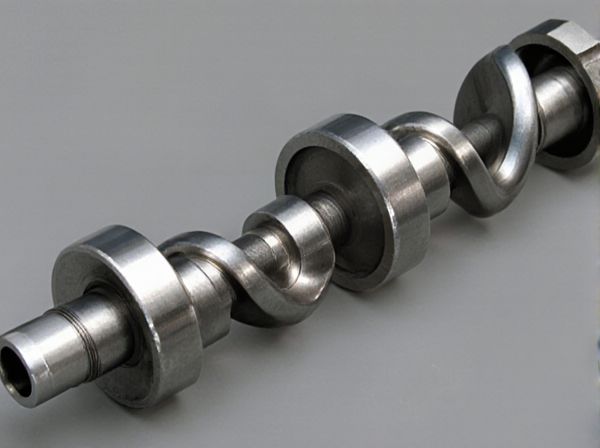
Photo illustration: Flat Tappet vs Roller Camshaft
A roller camshaft offers improved performance and durability compared to a flat tappet camshaft due to its reduced friction and wear resistance. Flat tappet camshafts are typically less expensive but require precise maintenance to avoid premature wear and failure. Choosing the right camshaft depends on your engine type, budget, and desired power output.
Table of Comparison
| Feature | Flat Tappet Camshaft | Roller Camshaft |
|---|---|---|
| Follower Type | Flat tappet | Roller with bearings |
| Friction & Wear | Higher friction, more wear | Lower friction, less wear |
| Performance | Standard power output | Improved power and efficiency |
| Durability | Moderate lifespan | Longer lifespan |
| Cost | Lower initial cost | Higher initial cost |
| Maintenance | Requires frequent adjustments | Less frequent adjustments needed |
| Application | Older vehicles, budget builds | High-performance and modern engines |
| Oil Requirements | Requires zinc-rich oil additives | Standard oil suitable |
Introduction to Flat Tappet and Roller Camshafts
Flat tappet camshafts feature a lifter with a flat surface that rides directly on the cam lobe, creating more friction and wear but offering simplicity and cost-effectiveness. Roller camshafts use lifters with rolling bearings that reduce friction and increase durability, making them preferred for high-performance engines and extended longevity. Understanding these fundamental differences in camshaft design helps optimize engine performance, maintenance requirements, and component lifespan.
How Flat Tappet Camshafts Work
Flat tappet camshafts operate by using a flat-faced lifter that slides directly along the camshaft lobe, creating a simple yet effective mechanism for opening and closing engine valves. The flat tappet design requires proper lubrication and break-in procedures to prevent excessive wear due to the increased friction between the lifter and cam lobe. This type of camshaft is favored for its cost-effectiveness and ease of maintenance but tends to produce more friction compared to roller camshafts.
Understanding Roller Camshaft Technology
Roller camshaft technology features cam lobes with rolling elements that reduce friction and wear compared to flat tappet camshafts, leading to enhanced engine efficiency and durability. These camshafts enable higher RPM capabilities and improved valve timing precision, resulting in better overall engine performance. Advances in materials and manufacturing have made roller camshafts the preferred choice for modern high-performance and fuel-efficient engines.
Key Differences Between Flat Tappet and Roller Camshafts
Flat tappet camshafts use lifters with flat surfaces sliding over the cam lobes, resulting in higher friction and wear compared to roller camshafts, which utilize rollers to reduce friction and improve durability. Roller camshafts provide more aggressive cam profiles and better valve timing precision, enhancing engine performance and efficiency. The flat tappet design is simpler and often less expensive but requires specific lubrication to prevent premature failure, while roller camshafts demand more complex manufacturing and higher upfront costs.
Performance Comparison: Flat Tappet vs Roller Camshaft
Roller camshafts offer superior performance due to reduced friction and enhanced valve control, resulting in increased horsepower and improved engine efficiency compared to flat tappet camshafts. Flat tappet camshafts, while more cost-effective and simpler in design, often face limitations in high-RPM applications due to increased wear and potential for valve float. Engine builders prefer roller camshafts for aggressive performance builds, as their ability to maintain precise valve timing under high stress significantly boosts acceleration and durability.
Durability and Longevity Considerations
Roller camshafts offer superior durability compared to flat tappet camshafts due to reduced friction and wear from their rolling contact design, which minimizes metal fatigue and cam lobe wear. Flat tappet camshafts often require high-quality oil additives and frequent maintenance to prevent premature failure caused by increased friction and heat. The longevity of roller camshafts typically exceeds that of flat tappet cams, making them ideal for high-performance and long-lasting engine builds.
Maintenance and Lubrication Requirements
Flat tappet camshafts require frequent oil changes with high-zinc content motor oils to prevent premature wear due to metal-to-metal contact and maintain proper lubrication of lifters. Roller camshafts reduce maintenance needs by minimizing friction and wear through cam-followers with bearings, allowing the use of standard motor oils with better longevity. Proper lubrication for roller cams ensures lifter retention and extends camshaft life, while flat tappet cams demand stricter oil and maintenance controls to avoid early failure.
Cost Analysis and Budget Implications
Flat tappet camshafts generally cost less upfront compared to roller camshafts due to simpler design and manufacturing processes, making them a budget-friendly choice for cost-sensitive engine builds. Roller camshafts, while more expensive initially, offer longevity and improved performance, which can reduce long-term maintenance and rebuild costs. Evaluating total ownership expenses reveals that roller camshafts may provide better value over time despite higher initial investment.
Ideal Applications for Each Camshaft Type
Flat tappet camshafts excel in classic car restorations and budget builds due to their simplicity and compatibility with older engine designs. Roller camshafts are ideal for high-performance and modern engines, offering reduced friction, increased durability, and improved valve timing precision. Enthusiasts seeking maximum horsepower and efficiency typically prefer roller cams for aggressive street or racing applications.
Choosing the Right Camshaft for Your Engine
Choosing the right camshaft for your engine depends on performance goals and engine type, where flat tappet camshafts offer simplicity and cost-effectiveness for low to moderate RPM ranges while roller camshafts provide improved durability and higher RPM capability due to their reduced friction design. Roller camshafts enhance valve train efficiency by minimizing wear and maximizing lift, making them ideal for high-performance and racing engines seeking aggressive timing and increased power. Consider compatibility with existing components and intended use, as flat tappet cams require specific lifters and break-in procedures, whereas roller cams demand less maintenance and allow for more advanced cam profiles.
 caratoz.com
caratoz.com